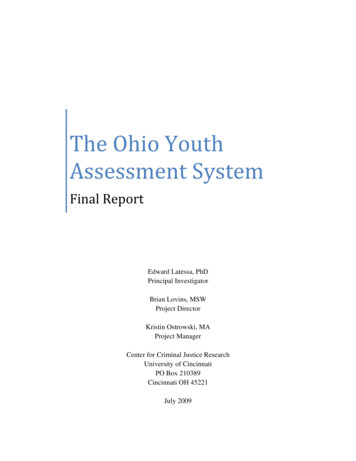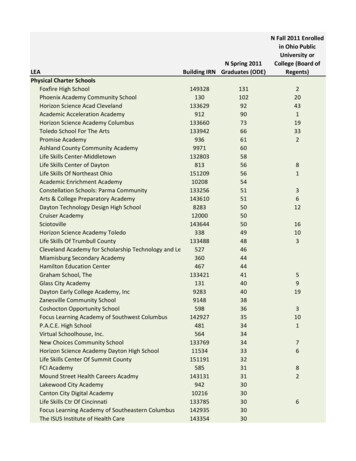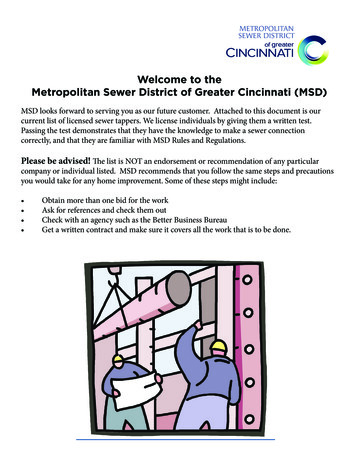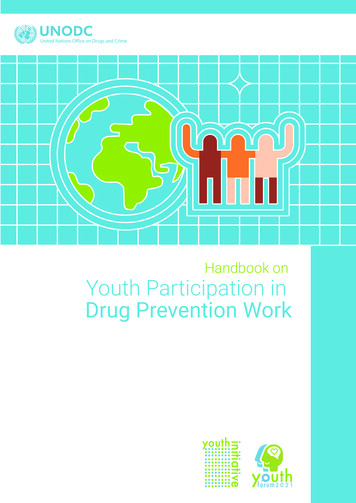
Transcription
The Ohio YouthAssessment SystemFinal ReportEdward Latessa, PhDPrincipal InvestigatorBrian Lovins, MSWProject DirectorKristin Ostrowski, MAProject ManagerCenter for Criminal Justice ResearchUniversity of CincinnatiPO Box 210389Cincinnati OH 45221July 2009
AcknowledgmentsThe University of Cincinnati, Center for Criminal Justice Research would like to acknowledgethe Ohio Department of Youth Services for their support in developing the OYAS. Specialthanks to Director Tom Stickrath, Brenda Cronin, Dave Schroot, Linda Modry, Ryan Gies,Hannah Phillips, and Hannah Able.In addition to ODYS staff, we would like to extend thanks to the following counties/programsfor participating in the development of the Ohio Youth Assessment yCCFsSciotoii
ContentsAcknowledgments. iiBackground . 1Review of the Principles of Effective Classification . 3The Risk Principle. 3The Need Principle . 4The Responsivity Principle . 4Professional Discretion . 5Methods . 5Sample . 8Outcomes . 11Results . 11Ohio Youth Assessment System-Diversion . 12Ohio Youth Assessment System-Detention . 16Ohio Youth Assessment System-Disposition . 19Ohio Youth Assessment System-Residential . 25Ohio Youth Assessment System-Reentry . 30Summary and Recommendations. 36iii
As of 2005, 77 different risk assessments across 88 counties were used to make decisionsregarding youth and their future.BackgroundIn 2004 the Ohio Department of Youth Services approached the University of CincinnatiCenter for Criminal Justice Research (CCJR) to evaluate the RECLAIM funded programs. Indoing so, Lowenkamp and Latessa (2005) found evidence that the effectiveness of theRECLAIM funded programs was mitigated by the risk level of the youth being served in theprogram. Overall the study found that lower risk youth were best served in the community whilehigher risk youth did as well if not better in more intensive programs (i.e., in CommunityCorrections Facilities and ODYS facilities).Although the risk principle has been well established in the literature, this study was oneof the first to test the principle on a wide range of youth across multiple settings (see Gendreau1996; Andrews and Bonta 2006). With results in hand, ODYS surveyed the courts to betterunderstand the “state” of risk assessment across Ohio’s 88 counties. Although ODYS adoptedthe Youthful Level of Service/Case Management Inventory (YLS/CMI) for youth entering aCCF or ODYS facility, local courts had the ability to adopt any types of assessments (or none atall) to assist in making decisions regarding youth. Based on the results of the ODYS AssessmentSurvey, it was determined that there were 77 different instruments used to assess risk across the88 counties.The large number of different assessment instruments made it apparent that there was aneed for a common assessment instrument. Director Thomas Stickrath seized the opportunity1
and initiated the development of a statewide risk assessment that would be available to all 88counties, CCF’s, and ODYS facilities. Thus, DYS commissioned the University of Cincinnati(UC) to research and develop an assessment process, and sought and received a grant fromOJJDP to assist in funding the project. In order to develop the tools, UC worked collaborativelywith DYS, juvenile courts, community corrections facilities, and community programs throughthe development of a pilot team that supplied insight and support to the project.For the Ohio Youth Assessment System (OYAS) to have a major impact on the Ohiojuvenile justice system it is important to encourage as many counties as possible to adopt it.Since Ohio is a home-rule state, local courts have the autonomy to choose local proceduresincluding whether or not to use a validated risk/need instrument. For this reason courts werebrought into the development of the OYAS early. Several kick-off meetings were held to discussthe implications of the OYAS and the benefits of using the system statewide. Beyond the pilotcommittee, courts were solicited regarding the potential for using the instrument. Initial interestof the assessment system was high with a majority of courts interested in potentially using thetools and another 24 courts willing to participate in the pilot committee.The pilot committee was charged with several tasks. First, the committee was to assistODYS and UC with arranging local interviews of youth. The OYAS was developed using aprospective research design which placed a strong emphasis on recruitment of youth into thestudy (See the Methods section for more details). Second, the committee supplied UC withinformation regarding the utility of the assessment tools. One of the original goals of the OYASwas to develop a system that was easily utilized by staff. Third, the courts were responsible forcollecting outcomes on all the youth that originated from their county whether they were servedlocally, at a CCF, or a DYS facility. Fourth, the Pilot Committee courts (with additional2
counties/programs added) field tested the instruments and provided feedback to UC regarding theinstruments, interview guides, and scoring procedures.Review of the Principles of Effective ClassificationAlthough 4th generation risk instruments are relatively new, assessing risk is not. Asearly as 1923 with the development of the Burgess Scale, courts have used research based toolsto best classify offenders in appropriate categories. In the late 1970’s and 1980’s researchers “rediscovered” the conversation of risk assessment with the introduction of the principles ofeffective classification. Based off early research conducted by Gendereau, Andrews and Bontaused the risk and need principles to guide the development of a 3rd generation risk/need tool.With this tool (along with contemporary assessment tools like the Wisconsin Risk and NeedInstrument) mainstream corrections was introduced to dynamic risk assessment.The Risk PrincipleThe risk principle proposes that the intensity of service be matched to the risk level of theoffender (Andrews, Bonta, and Hoge, 1990). In practice, the risk principle calls for focusingresources on the most serious cases, with high risk offenders benefiting most from intensiveservices and low risk youth left to minimal services (Andrews et al., 1990; Lowenkamp andLatessa 2004) . In fact, there is some research that suggests that providing intensive treatment tolow risk cases can have a detrimental impact on low risk youth because it exposes them to higherrisk offenders and disrupts their prosocial community networks (for a discussion see Lowenkampand Latessa 2004).3
The Need PrincipleThe need principle focuses on targeting appropriate criminogenic factors. Dynamic riskfactors (also called criminogenic needs) are those factors that, when changed, have been shownto result in a reduction in criminal conduct (Andrews et al 1990). Although this may makesense, many correctional interventions are developed that seek to change factors that areunrelated related to recidivism (see Latessa, Cullen, and Gendreau, 2002).Some of the mostpromising criminogenic targets include criminogenic thoughts and attitudes (also called antisocial cognitions), antisocial peer associations, poor parental monitoring and supervision,identification with antisocial role models, poor social skills, and substance abuse (Andrews et al.1990).The Responsivity PrincipleThe responsivity principle involves matching treatment styles and modalities to theclientele (Andrews, Bonta, and Hoge, 1990). Not only is it important that dynamic risk factorsbe targeted in high risk offenders, the treatment must be delivered in a manner in which theoffender can learn. This is especially important when working with individuals involved in thecriminal justice system because often times their learning styles are different from the generalpopulation. For example, a program that requires clientele to write their antisocial thoughts in ajournal as homework will not be beneficial to an offender that cannot read or write. There aretwo types of responsivity, general and specific.General responsivity involves utilizing treatment modalities that have been shown towork with offending populations. Treatment modalities that conform to the principle of generalresponsivity are social learning, cognitive and behavioral programs (Andrews et al., 1990; Cullen4
and Gendreau 2000). Specific responsivity involves tailoring programming to meet individualclients’ needs. Although the above listed treatment modalities have been found to work foroffending populations in general, factors such as low IQ, language, and reading ability caninterfere with the ability of a program to change dynamic risk factors. As a result, it is alsoimportant the programs assess offenders for specific characteristics that may interfere with theirability to engage in the treatment program.Professional DiscretionAlthough actuarial assessment tools work to remove a degree of discretion from criminaljustice actors by forcing them to make classification decisions based on known and objectivecriteria, it is important that the professional judgment not be eliminated completely (Andrews,Bonta, and Hoge, 1990). Assessment tools are designed to consider offenders in the aggregateand it is not possible for instruments of this nature to anticipate the risks and needs of everyindividual offender. As a result, allowing for professional override in certain circumstances is akey component of any assessment system. However, it is important that the number of overridesbe limited to extraordinary circumstances and that efforts be taken to provide oversight of theoverride process (Andrew, Bonta & Hoge, 1990).MethodsThe development of the OYAS was completed in several stages. First extant researchwas reviewed to determine the primary predictors of juvenile recidivism. From the currentresearch, data collection instruments were created for the purpose of interviewing youth across5
the Ohio juvenile justice system. Three sets of instruments were created depending on the stagein which the youth was interviewed.The first stage youth were assessed was at court intake. Probation officers and courtintake staff collected data on these youth as they entered the system at first contact. For some ofthe youth this was at intake to detention, while other youth were seen by a diversion officer. Ifthe youth was seen at detention that data were used to develop the detention instrument, and ifthe youth was seen by a diversion or intake worker the data were included in the diversioninstrument. Data were collected through a two-part questionnaire. Part I was a survey of itemsto be completed by the court staff. Part II was a self report questionnaire the youth completed(See Appendix A for the pre-disposition surveys).The second stage of the juvenile justice system that data were collected was postadjudication/disposition. Youth in this sample were interviewed by UC staff on the dispositionquestionnaire after the adjudication/disposition hearing and placed on probation.Thedisposition questionnaire was developed and used for youth who were placed on probation orreceived short-term (less than 3 month) stays in a residential program.The dispositionquestionnaire was conducted in 3 parts. Part I was a face-to-face structured interview conductedby UC researchers. The interview was approximately 45 minutes and surveyed over 400 itemsacross 9 primary domains (See Appendix B for the disposition surveys).Part II of thedisposition data collection tool was a self-report questionnaire which the youth completed priorto the interview. The self-report was conducted to determine if there were items that could bemeasured through a survey provided to the youth as to reduce staff resources in conducting theinterviews. Part III was a file review of the youth’s official court record.6
The third stage that data were collected was entry to a long-term residential program. Foryouth placed in a long-term residential program, the residential questionnaire was used. Theresidential questionnaire was developed to assess youth who were currently in a residentialprogram for a minimum of 3 months. Similar to the disposition questionnaire, the residentialquestionnaire was comprised of 3 parts. Part I was the face-to-face structured interview. Part IIwas the self-report questionnaire, and Part III was the file review form (See Appendix C forResidential Surveys).The fourth stage of the juvenile justice system that data were collected was release fromresidential programs including CCF and ODYS facilities.As youth transitioned to thecommunity, data were collected through the residential data collection tool. Since the residentialdata collection tool was developed to incorporate community as well as residential factors, thistool was deemed the most appropriate. Youth in this stage were assessed just prior to theirrelease from the residential program to ensure that data on a range of youth would be availableversus data on just those youth who attended parole.Upon completion of the interviews the results were coded into a Microsoft Accessdatabase and then transferred to SPSS for initial analyses. While the initial data were beinganalyzed, counties were collecting outcomes on youth in the study. The list of youth wasprovided back to the local courts for the purpose of recidivism checks. Each court ran recidivismon the youth through both local and statewide databases. In addition UC used the Ohio LawEnforcement Gateway (OhLEG) system to cross check the arrests reported by the courts. Onceall the outcomes were collected and entered, data analyses were conducted on each sample.7
SampleIndependent samples were drawn for the development of each instrument. Table 1 showsthe sample used to construct each instrument. Samples were selected from the local court,detention, local programs, CCFs and ODYS. In all there were a total of 2,457 cases interviewed,with 790 pre-adjudication interviews, 594 county interviews, 823 interviews from CCF’s,ODYS, and long-term residential programs and 250 youth at release from ODYS and CCF’s forthe reentry sample.Table 1: Number of Cases in Each lReentryTotalNumber of Cases7905948232502,457To ensure equal representation of gender, females were oversampled. Table 2 providesthe breakdown of the sample by on gender. As noted there were representative numbers ofmales and females in the pre-adjudication and disposition samples, but relatively few females inthe residential sample.This was primarily due to significantly fewer females placed inresidential care. In fact, out of the females brought into ODYS during the study period, 85percent of all females participated in the study.Table 2: Distribution of the Samples by lReentryTotalNumber of Males(%)493 (62.4%)360 (60.6%)727 (87.1%)203 (81.2%)1,798 (73.1%)Number of Females (%)297 (37.6%)204 (39.4%)95 (12.9%)47 (18.8%)659 (26.8%)8
Table 3 provides a review of the number of youth in the sample from each county orprogram. Youth from 18 counties were assessed for the pre-adjudication instruments. Of thecounties that participated, 37 percent (295) of the youth came from Franklin County, whileMarion County accounted for 16 percent (123) of the total sample. The rest of the 16 countiesprovided a range from 4 to 55 youth.The disposition sample was drawn from 23 counties for a total of 594 youth. The numberof youth ranged from 3 to 38, with the average providing 26 interviews. The residential samplewas drawn from CCFs, community residential programs, and ODYS facilities. A total of 14residential facilities were assessed.The reentry sample was drawn from youth leaving the facility or currently on parole.Very few youth were interviewed while on parole due to constraints regarding a secure settingfor interviews. To compensate for the lack of youth in the community, youth were interviewedat CCFs, community residential programs, and ODYS facilities with less than 60 days left ontheir stay. Only 31 of the 250 youth interviewed were actually in the community at the time ofthe interview. Since the data collection tool was designed to be used in a residential program aswell as capture community items this did not pose a barrier to developing the reentry instrument.9
Table 3: Distribution of Samples by 313837303633430287829313413564ResidentialCCFButler Co. CCFHocking Valley CCFJRCNWO/Wood Co CCFLucas Co. YTCMiami Valley CCFMontgomery Co. CCFNCORCNorthern OH JCCFOakview JRCPaint CreekPerry Multi-Co. CCFScioto GirlsScioto ReceptionStark Multi-Co. CCFUnion COYCWest Central 823LocationCircleville JCFCuyahoga Hills JCFFreedom CenterIndian River JCFMarion JCFMohican JCFOhio River Valley JCFScioto GirlsAkron ParoleDayton ParoleCincinnati ParoleColumbus ParoleToledo ParoleTotalCases21219193627503631329425010
OutcomesThe outcomes for this project were primarily collected by the counties.Whenappropriate, UC supplemented follow-up data with records from the Ohio Law EnforcementGateway (OHLEG) database. The follow-up period for the project ranged from 9 months to 19months, while the average follow-up time was 14 months. For the youth assessed at intake, thef
th generation risk instruments are relatively new, assessing risk is not. As . disposition data collection tool was a self-report questionnaire which the youth completed prior to the interview. The self-report was










